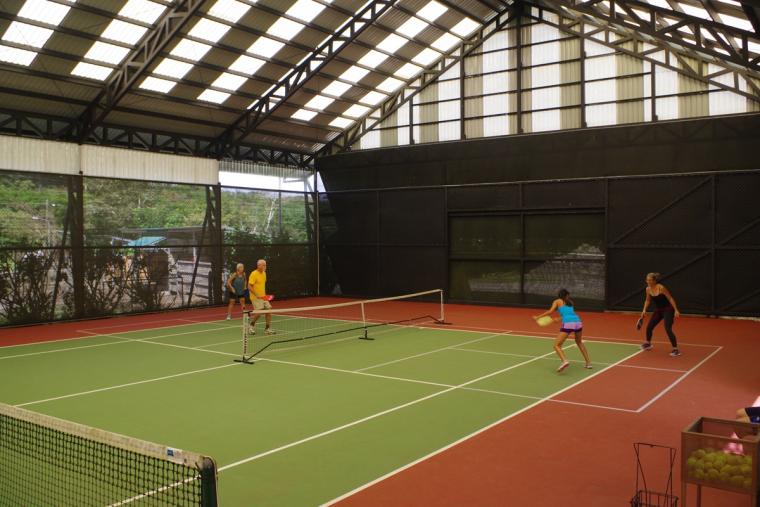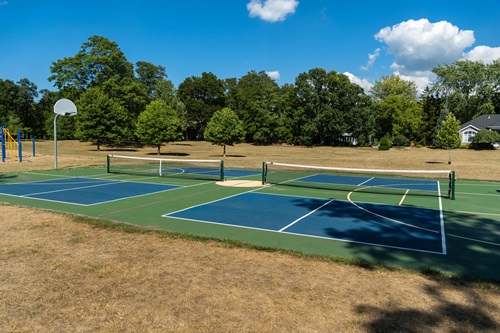
Some things never change. One of them is the tension between the playing populations for tennis and pickleball.
Despite the fact that cities have, largely, moved away from trying to get the two factions to share space (a Hatfields/McCoys recipe if there ever was one), the problem is still simmering.
Some bloggers are taking sides. One headline explained: “Why Pickleball is Killing Tennis.” A YouTube video, meanwhile, is entitled “Why Tennis Snobs Hate Pickleball Players.”
No matter your thoughts, there’s one point of agreement: Venues are caught in the middle.
Last year, in Arlington, Virginia, tennis players distributed hundreds of flyers to neighborhood residents, accusing pickleball players of bullying their children and of pushing out basketball players, as well as of public urination. It was the latest salvo following a decision to convert the current three outdoor tennis courts to nine pickleball courts by adding netting, pavement, lighting, signage, fencing, and “sound reduction measures.”
The tennis players also noted that pickleball courts would bring in not just players who were local, but those who came from outside the area as well, something that would add to traffic congestion and parking problems, as well as crowding and noise.
Pickleball players, as it turns out, excel at locating courts, thanks to an assist from their national governing body. USA Pickleball has a comprehensive Places2Play database that lists courts across the U.S. The list is kept updated as new courts are added. And that was exactly what the tennis enthusiasts of Arlington were worried about.
On the opposite coast, a slightly different version of the same argument was playing out. In San Diego, residents living near a pickleball court filed a lawsuit, alleging that players were causing too much noise with their game. (The problem of noise from pickleball is ongoing; as recently as this past fall, USA Pickleball announced the launch of a “quiet” category of equipment, as well as taking steps to mitigate noise in other ways.)
Additionally, when the local pickleball community asked that a tennis facility (which they claimed was run-down and underused) be converted for pickleball-only use, they received pushback from the local Peninsula Tennis Club, despite the fact that the Barnes Tennis Center, one of the top tennis facilities in the nation, was just across the street.
Reporters at the Voice of San Diego noted, “Local picklers’ zeal for new courts has been downright radical. In an effort to show the Point Loma tennis courts were underused, pickleball supporters hired drones to surveil them. They’ve even taken years’ worth of screenshots of Peninsula’s court logs to prove that many of the courts went unused. Peninsula tennis officials have disputed that characterization.
 Supporters of the upstart paddle sport then took their activism one step further. They stormed the courts, set up nets and a play-in demonstration sesh before police arrived to kick them out. Part of their complaint was that the tennis club, which is a nonprofit operating on public land, didn’t have a valid special use permit. Peninsula officials say that was on the Parks and Recreation department, which at the time had a significant backlog. Those tactics, and the coverage they generated, put tennis players on defense.”
Supporters of the upstart paddle sport then took their activism one step further. They stormed the courts, set up nets and a play-in demonstration sesh before police arrived to kick them out. Part of their complaint was that the tennis club, which is a nonprofit operating on public land, didn’t have a valid special use permit. Peninsula officials say that was on the Parks and Recreation department, which at the time had a significant backlog. Those tactics, and the coverage they generated, put tennis players on defense.”
Shortly thereafter, Barnes Tennis Center decided to add 19 pickleball courts to its property.
But not all battles end that well, notes The Guardian. In 2021, pickleball courts in Santa Rosa, California, were closed for several days after “at least six quarts of oil were spilled” on to their surface, the Press Democrat reported. Lying in the oil was a “profanity-laced note”, according to the newspaper, in which the writer threatened to scratch the cars of any pickleball players. It was attributed to tennis players – though nobody claimed direct responsibility.
Court vandalism was also reported in Boston, where, following heated-on-court disputes between pickleball players and tennis players, pickleball nets were removed, cut and thrown on the ground after hours.
The population of pickleball players is growing and while courts are going in, the demand is far outpacing the venues. Both sports grew during the COVID years and continue to have strong participation.
Hawai’i Public Radio interviewed Ron Romano, the executive director of the U.S. Tennis Association's Hawaii Pacific Section, about the tension and different cultures between tennis and pickleball players.
"We support pickleball. The health benefits are very similar. It's easy to play. It's social, it's fun, you get a lot of exercise," he said. "Our biggest and only concern is we don't want to lose tennis courts because we're growing, and we're maxed out."
The U.S. Tennis Association has created what it hopes is a template for both sports. Whether it will work… well, as with all plans, that remains to be seen. The document can be downloaded at this link. Here is a quick look at what it advises (in order of preference); the document also contains images of various types of facilities for reference:
Option #1: Sport-Specific Sites
The ideal solution, says USTA, is the development and/or expansion of sport-specific public sites. (In other words, there should be separate tennis facilities and pickleball facilities.) Facilities can be offered either as one central complex (but with different courts for each sport) or as two separate facilities.
Option #2: Non-Traditional Spaces
In the event that sport-specific sites are not possible, both tennis and pickleball can be played by creating courts for each in non-traditional spaces. USTA advised looking for hard surface areas that could possibly be converted, such as a concrete slab, multi-sport court sites and/or vacant parking lot locations. A court contractor can be brought in to measure the space, and to mark it with lines, as well as, if possible, to color-coat it for sports use.
Pop-up nets for tennis, as well as pop-up nets for pickleball, can be obtained affordably online; a search will yield multiple possibilities.
(Note: When contemplating any type of conversion affiliated with public facility infrastructure, safety must be at the forefront of all considerations. Further, local ordinances should be reviewed to ensure accessing the space for play is allowed.)
Option #3: Shared Use Of Courts
In the event that sport-specific sites and non-traditional spaces are not possible and in the interest of equitable offerings for both tennis and pickleball, destinations can still allow both sports to be played by having blended lines applied. (Note: Blended lines is the USTA’s term for multiple playing lines on any one surface.)
This recommendation is useful for sites with one or two tennis courts. For sites with three or more tennis courts, every effort should be made to utilize Options #1 or #2 because of the sustained growth and increasing public demand for both sports.
Diagrams can be found on the online document, illustrating how lines can be added to courts to facilitate play. Whenever possible, use the services of a skilled court-specific contractor to apply lines.
For additional information, contact the USTA Tennis Venue Services Team for complimentary consultative resources at www.usta.com/facilities or e-mail Facilities@usta.com. Other information can be found in the book, Pickleball Courts: Construction & Maintenance Manual, available at this link.

